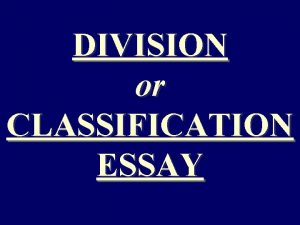DIVISION AND CLASSIFICATION DIVISION A writer practices division










- Slides: 10

DIVISION AND CLASSIFICATION

DIVISION • A writer practices division by separating a class of things or ideas into categories following a clear principle or basis.

CLASSIFICATION • In classification, a writer groups individual objects or ideas into already established categories.

DIVISION AND CLASSIFICATION • Division and classification can operate separately but often accompany each other. • In writing, division and classification are affected directly by the writer’s practical purpose—what the writer wants to explain or prove. • That purpose determines the class of things or ideas being divided and classified.

EXAMPLE • A writer might divide television programs according to their audiences (adults, families, or children) and then classify individual programs into each category to show that television networks value certain audiences more than others.

EXAMPLE • A writer who is concerned about violence in television programming would divide programs into those with and without fights and murders and then would classify several programs into those categories. • Other writers with different purposes might divide television programs differently (by the day and time of broadcast, for example, or by the number of women featured in prominent roles) and then would classify individual programs accordingly.

GUIDELINES FOR DIVISION AND CLASSIFICATION IN WRITING 1. Identify a clear purpose, and use a principle of division that is appropriate to that purpose. • For example, if you want to examine the common characteristics of four-year athletic scholarship recipients, you might divide them in terms of program of study, sport, or gender. It would not be useful to divide students based on their favorite type of music because that would be irrelevant to your purpose.

GUIDELINES FOR DIVISION AND CLASSIFICATION IN WRITING • Divide your subject into unique categories. An item can belong to only one category. • For example, don’t divide students as men, women, and athletes.

GUIDELINES FOR DIVISION AND CLASSIFICATION IN WRITING • Make your division and classification complete. Your categories should account for all items in a subject class. • For example, in dividing students on the basis of geographic origin, don’t consider only the United States because such a division does not account foreign students. For your classification to be complete, every student must be placed in one of the established categories.

GUIDELINES FOR DIVISION AND CLASSIFICATION IN WRITING • State the conclusion that your division and classification lead you to draw. • For example, after conducting your division and classification of athletic scholarship recipients, you might conclude that the majority of male athletes with athletic scholarships come from the western United States.



















